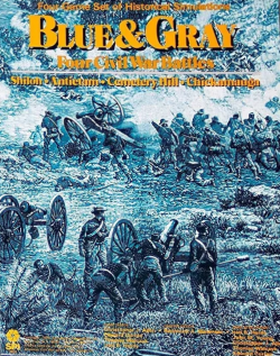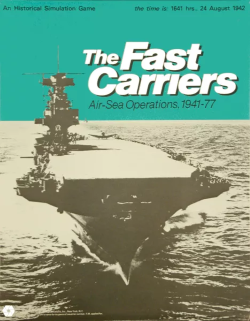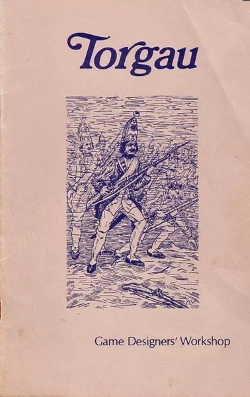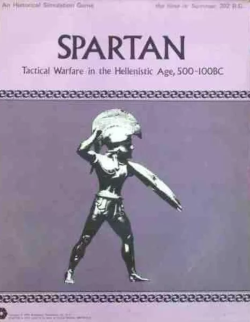
Battle for Germany is a board wargame published by Simulations Publications Inc. (SPI) in 1975 that simulates World War II operations in Germany during 1945

Tobruk, subtitled "Tank Battles in North Africa 1942", is a board wargame published by Avalon Hill in 1975 that simulates tank combat in North Africa during World War II.

StarForce: Alpha Centauri, subtitled "Interstellar Conflict in the 25th Century", is a science fiction board game published by Simulations Publications Inc. (SPI) in 1974. It was the first mass-market science fiction board wargame, and was a best-seller for SPI.

Armageddon: Tactical Combat, 3000-500 BC is a board wargame first published by Simulations Publications Inc. (SPI) in 1972 in Strategy & Tactics, then released as a stand-alone game, then reimplemented as Chariot: Tactical Warfare in the "Biblical" Age, 3000-500 BC.

Blue & Gray: Four American Civil War Battles is a board wargame originally published by Simulations Publications, Inc. (SPI) in 1975 that simulates four battles from the American Civil War.

The American Civil War: 1861–1865 is a board wargame published by Simulations Publications Inc. (SPI) in 1974 that is a strategic simulation of the American Civil War.

The Fast Carriers, subtitled "Air-Sea Operations, 1941–77" is a board wargame published by Simulations Publications Inc. (SPI) in 1975 that simulates naval combat involving aircraft carriers from 1941 to the mid-1970s.

Island War: Four Pacific Battles is a collection of four board wargames published in 1975 by Simulations Publications Inc. (SPI) that simulates various battles between American and Japanese forces during the Pacific Campaign of World War II.

MechWar '77, subtitled "Tactical Armored Combat in the 1970s", is a board wargame published by Simulations Publications Inc. (SPI) in 1975 that simulates hypothetical tank combat in the mid-1970s between various adversaries, using the same rules system as the previously published Panzer '44.

Napoleon at War, subtitled "Four Battles", is a collection of four board wargames published by Simulations Publications Inc. (SPI) in 1975 that simulates various battles fought by Napoleon.

Bloody Ridge, subtitled "Turning Point on Guadalcanal, September 1942", is a board wargame published by Simulations Publications Inc. (SPI) in 1975 that simulates the Guadalcanal Campaign during World War II. The game was originally published as part of the Island War: Four Pacific Battles "quadrigame" — a gamebox containing four games simulating four separate battles that all use the same rules. Bloody Ridge was also published as an individual "folio game."

Westwall: Four Battles to Germany is a collection of four board wargames published by Simulations Publications (SPI) in 1976 that simulate battles in Europe in late 1944 and early 1945 during World War II.

Blue & Gray II, subtitled "Four American Civil War Battles", is a collection of four board wargames originally published by Simulations Publications, Inc. (SPI) in 1975 that each simulate a battle from the American Civil War. It is the sequel to Blue & Gray published earlier in the year. Each of the four games was also published as individual "folio games."

Chariot: Tactical Warfare in the Biblical Age, 3000-500 B.C. is a board wargame published by Simulations Publications Inc. (SPI) in 1975 that simulates various historical battles during the Bronze Age. The game originally started as Armageddon: Tactical Combat, 3000-500 BC, published in 1972, but was revised in order to become the first game in SPI's PRESTAGS collection.

Frigate: Sea War in the Age of Sail is a board wargame published by Simulations Publications Inc. (SPI) in 1974 that simulates naval combat in the 18th and 19th century Age of Sail.

Hurtgen Forest, subtitled "Approach to the Roer, November 1944 ", is a board wargame published by Simulations Publications Inc. (SPI) in 1976 that simulates the Battle of Hürtgen Forest during the final year of World War II. The game was originally published by SPI as part of a four-game collection titled Westwall: Four Battles to Germany, but it was also released as an individual "folio game." While the quadrigame Westwall received good reviews from critics, the static nature of Hurtgen Forest was less well received.

Jena-Auerstadt: The Battle for Prussia is a board wargame published by Simulations Publications Inc. (SPI) in 1975 that simulates the twin battles of Jena and Auerstadt in October 1806. It was one of four games that were part of the "quadrigame" titled Napoleon at War, but it was also released as an individual "folio game" packaged in a shrinkwrapped cardstock folio. Jena-Auerstadt was rated highly in a 1976 poll of favorite wargames, but critics questioned whether its simplicity was capable of simulating a complicated two-part battle.

Torgau is a board wargame published by Game Designers' Workshop (GDW) in 1974 that simulates the Battle of Torgau between Prussians and Austrians in 1760 during the Seven Years' War, a costly battle for both sides. Reviews were generally favorable, although gameplay was characterized as very long, complex, and more similar to traditional miniatures wargaming than board wargames.

Spartan: Tactical Warfare in the Hellenistic Age, 500-100BC is a board wargame published by Simulations Publications, Inc. (SPI) in 1975 that simulates battles during the rise of Greece to the period of Roman rule. Originally published by SPI as Phalanx, the game was revised and republished with the title Spartan as part of a series called PRESTAGS.

Leyte: Return to the Philippines, October 1944 is a board wargame published in 1975 by Simulations Publications Inc. (SPI) that simulates the return of General Douglas MacArthur to the Philippines during World War II. The game was originally published as part of the four-game collection Island War: Four Pacific Battles, but was also released as an individual game. Leyte was not considered an outstanding success by critics.




















